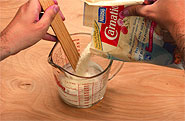Milk paint finish
The ultimate do-it-yourself finish: milk paint
There is nothing in this world that quite makes my day like learning a trade secret or technique that allows me to make my own gizmo, tool, or whatever, saving me the expense of “store bought.”
Maybe I’m cheap (I don’t really think so or I’d have a lot more in the asset column), but there is something that just delights my soul when I can cut out the middleman.
Now, I’m the first to admit that some of my experiments have turned out have turned out to be less than successful; soap-making does not bring back fond memories (I can still smell the stink of rendering beef fat and that was 26 years ago). On the other hand, I’ve had some experiences that I can add to my mental scrap book of happy thoughts.
One of my major interests in woodworking has always been the history of the craft. We have so many conveniences that we tend to take some things for granted that were just not available to the craftsmen of old. In this country, it wasn’t that long ago that the art of making something from the resources on hand was part of everyone’s resume.
Take paint, for instance. Have you ever wondered why the traditional colour of barns in this country is red? There was a time when every farmer knew a recipe for milk paint, and I’ll let you guess where the red pigment came from. (Hint: not tomatoes.)
What happened? Why did milk paint fall out of favour? Why is it suddenly becoming popular now? Can we make our own?
The Fall
Common sense indicates that milk paint had some exploitable weaknesses: it probably had a fairly short shelf life drying out into an unusable mess in a very short length of time. The colour red must have become monotonous after a while. And I think it might have been nice to get some paint when you needed it without having to butcher the hog first. And I would think, if a different pigment was used, it would be difficult to get the exact colour match if you ran out of paint before the project was finished.
All these problems were eventually addressed when commercial paint companies entered the scene; they were able to incorporate economy of scale and more sophisticated methods and technologies to efficiently produce a more convenient product.
Jump to a section
- Page 1 : Milk paint - strengths and weaknesses
- Page 2 : Where you can obtain it
- Page 3 : Various milk paint recipes
To leave a comment, please log in












No comments